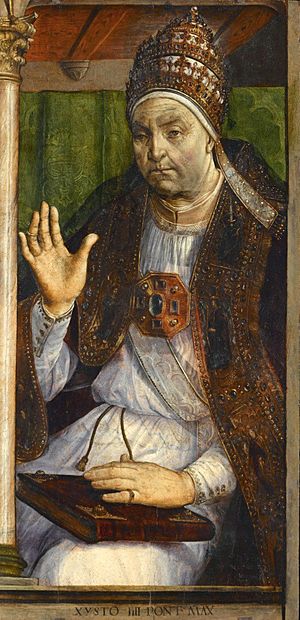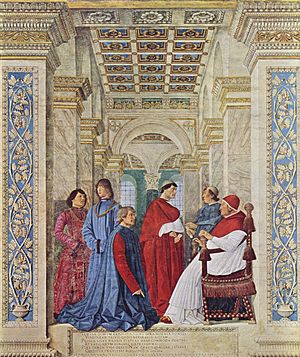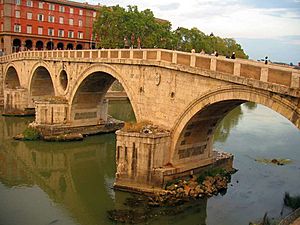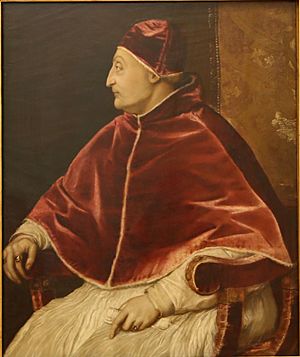Pope Sixtus IV facts for kids
Quick facts for kids Pope Sixtus IV |
|
|---|---|
| Bishop of Rome | |

|
|
| Church | Catholic Church |
| Papacy began | 9 August 1471 |
| Papacy ended | 12 August 1484 |
| Predecessor | Paul II |
| Successor | Innocent VIII |
| Orders | |
| Consecration | 25 August 1471 by Guillaume d'Estouteville |
| Created Cardinal | 18 September 1467 |
| Personal details | |
| Birth name | Francesco della Rovere |
| Born | 21 July 1414 Celle Ligure, Republic of Genoa |
| Died | 12 August 1484 (aged 70) Rome, Papal States |
| Previous post |
|
| Other Popes named Sixtus | |
| Papal styles of Pope Sixtus IV |
|
|---|---|
 |
|
| Reference style | His Holiness |
| Spoken style | Your Holiness |
| Religious style | Holy Father |
| Posthumous style | None |
Pope Sixtus IV (born Francesco della Rovere) led the Catholic Church and ruled the Papal States from August 9, 1471, until his death in August 1484. He was born on July 21, 1414, and died on August 12, 1484.
During his time as pope, he achieved many important things. He oversaw the building of the famous Sistine Chapel and started the Vatican Library. He also supported many artists, helping to bring the Renaissance art style to Rome.
Sixtus IV also created the Spanish Inquisition in 1478. He was known for giving important jobs to his family members, a practice called nepotism. He was also involved in a plot to remove the powerful Medici family from power in Florence.
Contents
Early Life and Rise to Power
Francesco della Rovere was born in Celle Ligure, Italy. His family was not wealthy. As a young man, he joined the Franciscan Order, a religious group.
He was very smart and studied philosophy and theology at the University of Pavia. Later, he taught at many Italian universities. In 1464, at age 50, he became the leader of the Franciscan Order.
In 1467, Pope Paul II made him a Cardinal. Before becoming pope, Cardinal della Rovere was known for his simple lifestyle. He wrote important books about religious topics. Because of his good reputation, the cardinals chose him to be the next pope after Paul II died.
Sixtus IV's Papacy
When Francesco della Rovere became pope, he chose the name Sixtus. This name had not been used by a pope since the 5th century. One of his first goals was to start a new crusade against the Ottoman Turks. However, this effort did not last long. For the rest of his time as pope, Sixtus focused on ruling the Papal States and helping his own family.
Nepotism and Family Influence

Pope Sixtus IV wanted to make his position stronger. He did this by giving important jobs and power to his relatives and friends. This practice is called nepotism.
In a famous painting by Melozzo da Forlì, Pope Sixtus IV is shown with his nephews. Some of them became cardinals. His nephew, Pietro Riario, became a cardinal and a very rich man in Rome. He was even in charge of the Pope's foreign policy.
Sixtus also helped his nephew Giovanni become a lord. He arranged Giovanni's marriage to the daughter of the Duke of Urbino. This led to the Della Rovere family becoming powerful dukes. Six of the 34 cardinals Sixtus created were his own nephews.
Foreign Relations and Conflicts
Sixtus IV had disagreements with King Louis XI of France. The king believed that papal rules needed his approval before they could be used in France. This caused conflict between the Pope and the French king.
In 1478, Sixtus IV allowed the Spanish Inquisition to be set up in Spain. This was a special court created to find and punish people who were not following Catholic rules. Sixtus agreed to this under pressure from King Ferdinand of Aragon. However, Sixtus IV later criticized the harsh actions of the Inquisition in 1482.
As a ruler, Sixtus IV built strong forts in the Papal States. He also encouraged the Venetians to attack Ferrara. He wanted to gain Ferrara for another one of his nephews. However, other Italian leaders joined together and forced Sixtus IV to make peace.
In 1483, Sixtus IV punished Venice for continuing these fights. He also raised money for the state by selling important offices and special rights.
In religious matters, Sixtus IV promoted the idea of the Immaculate Conception. He made December 8 a special feast day for it. He also officially cancelled the decisions made by the Council of Constance in 1478.
Slavery and Papal Bulls
Earlier popes had given Portugal the right to take slaves from the African coast. Sixtus IV confirmed these rights in his own official document, called a papal bull, in 1481. This document helped to support the idea of conquest and trade.
In 1476, Sixtus IV issued another bull. This one threatened to punish anyone who enslaved Christians. This was meant to encourage the conversion of people in the Canary Islands and Guinea. It also aimed to show a clear difference between those who had converted to Christianity and those who had not.
Supporting Arts and Sciences
Sixtus IV was a great supporter of building projects in Rome. He restored an ancient aqueduct that brought fresh water to the city. He also rebuilt or repaired over 30 churches and added seven new ones.
The famous Sistine Chapel was built under his sponsorship. He also built the Ponte Sisto, the first new bridge across the Tiber since ancient Roman times. He also created new roads to connect the Vatican Hill with the rest of Rome. He cleared out markets from the Campidoglio and ordered streets to be widened and paved.

In 1471, Sixtus IV started a papal art collection, which later became the Capitoline Museums. He also improved and expanded the Vatican Library. He brought famous singers and composers to Rome to improve the papal choir.
Sixtus IV also supported science. He allowed doctors and artists to study human bodies for research. This access helped the anatomist Vesalius create an important medical book called De humani corporis fabrica.
Other Important Actions
New Cardinals
Pope Sixtus IV created 34 new cardinals during his time as pope. Many of these cardinals came from important families in Italy, France, and Spain. This helped ensure that his policies would continue even after his death.
New Saints
Sixtus IV named seven new saints. The most well-known was Bonaventure in 1482. He also recognized one person, John Buoni, as blessed in 1483.
Uppsala University
In 1477, Sixtus IV issued a papal bull that allowed the creation of Uppsala University in Sweden. This was the first university in all of Scandinavia. Uppsala was chosen because it was an important religious center. The university was given the same rights and freedoms as the University of Bologna. This meant it could teach theology, law, medicine, and philosophy. It could also award different degrees. The archbishop of Uppsala was named the university's leader. This decision by Sixtus IV had a big impact on Swedish society and culture.
Death of Sixtus IV
Pope Sixtus IV became sick on August 8, 1484. His health worsened on August 10 while he was at an event in Rome. He felt unwell that evening and had to cancel a meeting with his cardinals. He grew weaker during the night of August 11 and could not sleep. Pope Sixtus IV died the next evening, on August 12, 1484.
His tomb was destroyed in 1527 during the Sack of Rome. Today, his remains are buried in St. Peter's Basilica, along with his nephew Pope Julius II. A marble stone marks their burial spot.
His bronze monument, which looks like a giant casket, is in the basement of St. Peter's Basilica. It was made by Antonio del Pollaiuolo. The top shows a lifelike image of the Pope. Around the sides are carvings of female figures representing subjects like Grammar, Music, and Painting. Each figure includes an oak tree, which was a symbol of Sixtus IV.
Portrayals in Media
Pope Sixtus IV has been shown in several films and TV shows:
- He is played by Arthur Grosser in the short film Assassin's Creed: Lineage.
- James Faulkner plays Pope Sixtus in the TV series Da Vinci's Demons. In this show, he has an identical twin brother who takes his place.
- Raul Bova and John Lynch have both played Pope Sixtus in the TV series Medici: Masters of Florence.
See also
 In Spanish: Sixto IV para niños
In Spanish: Sixto IV para niños


